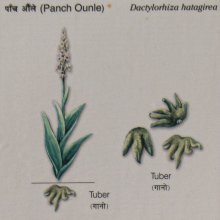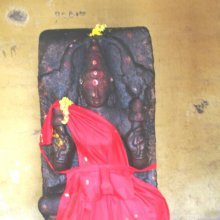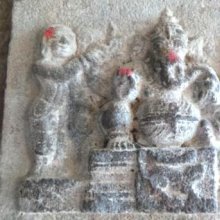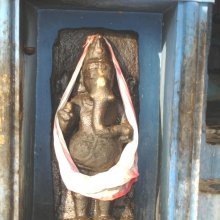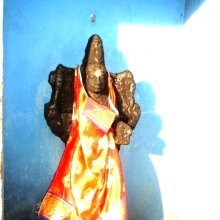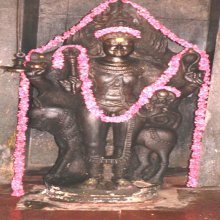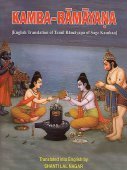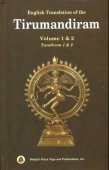Paca, Pacā, Pācā: 14 definitions
Introduction:
Paca means something in Hinduism, Sanskrit, Marathi, Jainism, Prakrit, Hindi, Tamil. If you want to know the exact meaning, history, etymology or English translation of this term then check out the descriptions on this page. Add your comment or reference to a book if you want to contribute to this summary article.
Alternative spellings of this word include Pacha.
Images (photo gallery)
(+9 more images available)
Languages of India and abroad
Marathi-English dictionary
Source: DDSA: The Molesworth Marathi and English Dictionarypaca (पच).—a S That cooks or ripens. In elegant comp. as sukhampaca, duḥkhampaca, kṛcchrampaca, alpampaca, mitampaca That cooks with ease, with difficulty &c.
--- OR ---
pāca (पाच).—f m An aromatic plant, Pogostemon Heyneanum. Grah.
--- OR ---
pāca (पाच).—m (S) An emerald.
Source: DDSA: The Aryabhusan school dictionary, Marathi-Englishpaca (पच).—a In comp. That cooks or ripens Ex. suṅkha paca du:khaṃ paca That cooks with ease, with difficulty &c.
--- OR ---
pāca (पाच).—f m An aromatic plant, Pogoste mon Heyneanum. Grab.
--- OR ---
pāca (पाच).—m An emerald.
Marathi is an Indo-European language having over 70 million native speakers people in (predominantly) Maharashtra India. Marathi, like many other Indo-Aryan languages, evolved from early forms of Prakrit, which itself is a subset of Sanskrit, one of the most ancient languages of the world.
Sanskrit dictionary
Source: DDSA: The practical Sanskrit-English dictionaryPaca (पच).—a.
1) Cooking, roasting.
2) Digesting.
-caḥ, -cā 1 Cooking.
2) Maturing.
--- OR ---
Pacā (पचा).—The act of cooking.
--- OR ---
Pācā (पाचा).—f. Cooking.
See also (synonyms): pāci.
Source: Cologne Digital Sanskrit Dictionaries: Shabda-Sagara Sanskrit-English DictionaryPaca (पच).—mfn.
(-caḥ-cā-caṃ) Who or what cooks, matures, &c. m.
(-caḥ) Cooking, maturing, &c. E. pac to cook, aff. ac.
--- OR ---
Pacā (पचा).—f.
(-cā) Cooking, dressing, maturing. E. pac to dress, affs. aṅ and ṭāp.
--- OR ---
Pācā (पाचा).—f.
(-cā) Cooking, maturing. E. pac to cook, causal v. aṅ and ṭāp affs.
Source: Cologne Digital Sanskrit Dictionaries: Benfey Sanskrit-English DictionaryPaca (पच).—[-pac + a], latter part of comp. adj. Cooking, baking, roasting.
Source: Cologne Digital Sanskrit Dictionaries: Cappeller Sanskrit-English DictionaryPaca (पच).—[adjective] cooking, boiling, roasting (—°).
Source: Cologne Digital Sanskrit Dictionaries: Monier-Williams Sanskrit-English Dictionary1) Paca (पच):—[from pac] 1. paca mfn. idem (cf. alpam-, iṣṭi-, kimetc.)
2) [v.s. ...] mf. the act of cooking etc., [cf. Lexicographers, esp. such as amarasiṃha, halāyudha, hemacandra, etc.]
3) [from pac] 2. paca 2. sg. [imperative] of √pac.
4) Pācā (पाचा):—[from pāka] (or pāci or pācikā) f. cooking, maturing, [cf. Lexicographers, esp. such as amarasiṃha, halāyudha, hemacandra, etc.]
Source: Cologne Digital Sanskrit Dictionaries: Yates Sanskrit-English Dictionary1) Paca (पच):—(caḥ) 1. m. Cooking, ripening.
2) Pacā (पचा):—(cā) 1. f. A cooking.
3) Pācā (पाचा):—(cā) 1. f. Cooking.
Source: DDSA: Paia-sadda-mahannavo; a comprehensive Prakrit Hindi dictionary (S)Pāca (पाच) in the Sanskrit language is related to the Prakrit words: Pāe, Vaya.
[Sanskrit to German]
Sanskrit, also spelled संस्कृतम् (saṃskṛtam), is an ancient language of India commonly seen as the grandmother of the Indo-European language family (even English!). Closely allied with Prakrit and Pali, Sanskrit is more exhaustive in both grammar and terms and has the most extensive collection of literature in the world, greatly surpassing its sister-languages Greek and Latin.
Hindi dictionary
Source: DDSA: A practical Hindi-English dictionaryPaca (पच):——an allomorph of [pāṃca; ~kalyānī] cunning; wicked; ~[khanā] five-storeyed; ~[gunā] five times; five-fold; ~[mela] a mixture of five ingredients; five different sweetmeats mixed together; ~[raṃgā] multi-coloured; five-coloured; ~[laḍā] a five-stringed necklace.
...
Prakrit-English dictionary
Source: DDSA: Paia-sadda-mahannavo; a comprehensive Prakrit Hindi dictionaryPaca (पच) in the Prakrit language is related to the Sanskrit word: Pac.
Prakrit is an ancient language closely associated with both Pali and Sanskrit. Jain literature is often composed in this language or sub-dialects, such as the Agamas and their commentaries which are written in Ardhamagadhi and Maharashtri Prakrit. The earliest extant texts can be dated to as early as the 4th century BCE although core portions might be older.
Tamil dictionary
Source: DDSA: University of Madras: Tamil LexiconPaca (பச) [pacattal] 12 intransitive verb
1. To be green; பசுமையாதல். மாலு மோர்பா லோங்கிய வண் ணம் போன்று மொளிநிறம் பசந்து தோன்ற [pasumaiyathal. malu morpa longiya van nam ponru moliniram pasanthu thonra] (திருவிளையாடற் புராணம் யானையெய். [thiruvilaiyadar puranam yanaiyey.] 27).
2. To turn sallow or pale, as the skin through love-sickness; காமத்தால் மேனி பசலைநிறமாதல். பசந்தக்காலும் பசப்பொல்லாதே [kamathal meni pasalainiramathal. pasanthakkalum pasappollathe] (குறுந்தொகை [kurundogai] 264).
3. To lose lustre, complexion or colour through love-sickness; காமநோய் முதலிய வற்றால் ஒளிமங்குதல். பூப்போ லுண்கண் பசந்து [kamanoy muthaliya varral olimanguthal. puppo lunkan pasanthu] (புறநானூறு [purananuru] 96).
4. To become dim, as twilight; மங்கிப்போதல். [mangippothal.] (W.)
5. To become golden, as the sky in the evening; பொன்னிறங்கொள்ளுதல். திசைமுகம் பசந்து [ponnirangolluthal. thisaimugam pasanthu] (சிலப்பதிகாரம் அரும்பதவுரை [silappathigaram arumbathavurai], 4, 5).
Tamil is an ancient language of India from the Dravidian family spoken by roughly 250 million people mainly in southern India and Sri Lanka.
See also (Relevant definitions)
Starts with (+193): Paca-Kana-Kara-Dini-Dishi, Pacab, Pacabhaiya, Pacacalam, Pacacam, Pacacamatantai, Pacacaratam, Pacad, Pacada, Pacadi, Pacaga, Pacaha, Pacahara, Pacahattara, Pacahattaraum, Pacai, Pacai guava, Pacaiman, Pacaimattai, Pacaintar.
Ends with (+29): Acopaca, Alpampaca, Amitampaca, Anamitampaca, Anapaca, Apaca, Campaca, Carissa opaca, Champaca, Clusia opaca, Doho Bapaca, Dronampaca, Dushpaca, Fragrant champaca, Gacapaca, Garudapaca, Ghacapaca, Huepaca, Ilex opaca, Ishtipaca.
Full-text (+159): Pasas, Pacampaca, Prakuta, Pacaprakuta, Nakhampaca, Pacalavana, Pacamocanam, Mrityava, Alpampaca, Pasha, Shvapaca, Pachas, Pancejodi, Pacasa, Pacapaca, Pacha, Mitampaca, Pasavu, Pasanu, Pullaaniyila pacha.
Relevant text
Search found 28 books and stories containing Paca, Pāca, Pacā, Pācā, Pacha, Pasa; (plurals include: Pacas, Pācas, Pacās, Pācās, Pachas, Pasas). You can also click to the full overview containing English textual excerpts. Below are direct links for the most relevant articles:
Guhyagarbha Tantra (with Commentary) (by Gyurme Dorje)
Chapter 16 - Emanation of the Maṇḍala of Buddha-speech < [Chapter 16 (Text and Commentary)]
Text 16.2 (Commentary) < [Chapter 16 (Text and Commentary)]
The Garuda Purana (by Manmatha Nath Dutt)
Chapter XLI - Enumeration of diverse incantations, Mantras (Nana Vidya) < [Agastya Samhita]
Tiruvaymoli (Thiruvaimozhi): English translation (by S. Satyamurthi Ayyangar)
Pasuram 2.10.4 < [Section 10 - Tenth Tiruvaymoli (Kilar oli ilamai)]
Pasuram 3.2.10 < [Section 2 - Second Tiruvaymoli (Munnir nalam)]
Pasuram 3.3.4 < [Section 3 - Third Tiruvaymoli (Olivu il kalam)]
Satapatha-brahmana (by Julius Eggeling)
Kāṇḍa XIII, adhyāya 2, brāhmaṇa 9 < [Thirteenth Kāṇḍa]
The Religion and Philosophy of Tevaram (Thevaram) (by M. A. Dorai Rangaswamy)
Chapter 3.6 - Kalasamhara-murti (Markandeya and the conquest of death) < [Volume 2 - Nampi Arurar and Mythology]
Chapter 3.1 - Tripurantaka-murti (burning down of the three castles) < [Volume 2 - Nampi Arurar and Mythology]
Chapter 1.1 - Arurar’s Language of Mythology < [Volume 2 - Nampi Arurar and Mythology]
Chaitanya Bhagavata (by Bhumipati Dāsa)
Verse 2.10.102 < [Chapter 10 - Conclusion of the Lord’s Mahā-prakāśa Pastimes]
Verse 2.41 < [Chapter 2 - The Lord’s Manifestation at the House of Śrīvāsa and the Inauguration of Saṅkīrtana]
Verse 2.10.100 < [Chapter 10 - Conclusion of the Lord’s Mahā-prakāśa Pastimes]
Related products
